
姚佳,北京师范大学政府管理学院本科毕业生(中国)
点击链接观看发言视频:在数字全球化背景下,弥合数字鸿沟以应对学习危机
姚佳认为,技术利用不足、合格的教师缺乏、获得高质量教育的机会不足是中国面临的三大学习危机,而新冠疫情给又教育工作者带来了更多挑战。数字鸿沟是目前产生学习危机的一个重要因素。
她认为,中国在疫情期间的经验值得借鉴,如建设可靠的网络基础设施、使用便捷的学习工具和平台、提供适切的数字学习资源等。习近平主席在2020年中国国际服务贸易交易会全球服务贸易峰会上提出:“我们要顺应数字化、网络化、智能化发展趋势,共同致力于消除‘数字鸿沟’。另外,“中国智慧教育”、“三个教室”、“教师信息技术能力提升培训2.0”等相关举措也取得了成功。她呼吁联合共建网络空间命运共同体,弥合“数字鸿沟”,以应对当今的学习危机。

YAO Jia (China), Undergraduate student, Beijing Normal University
YAO Jia pointed out three striking features of China's learning crisis: underutilization of technology, lack of qualified teachers and insufficient access to education. Furthermore, the global disruption to education caused by the COVID-19 pandemic constitutes the worst crisis on record. Those emerging challenges manifest the fact of the digital divide, which is the main factor of learning crisis.
Further, she shared some experiences from China during the covid-19 pandemic, including internet infrastructural construction, convenient learning tools and platforms and digital learning resources. Xi Jinping, President of the People's Republic of China, remarks at the Global Trade in Services Summit of the 2020 China International Fair for Trade in Services, "We need to respond to the trend of digitalization, networking and intelligence, and work together to bridge the 'digital divide." In addition, she delivered three successful examples of bridging the digital divide to tackle the learning crisis, including the national platform called smart education of China, the mixed-mode education initiative named "three classrooms", and the Teachers' IT Capacity Enhancement Training 2.0 version. Ultimately, she calls for turning the crisis into the opportunity to make an urgent systematic change in education and work towards building a community of shared futures.
论坛回放:学习危机与教育的未来论坛(学生论坛)


